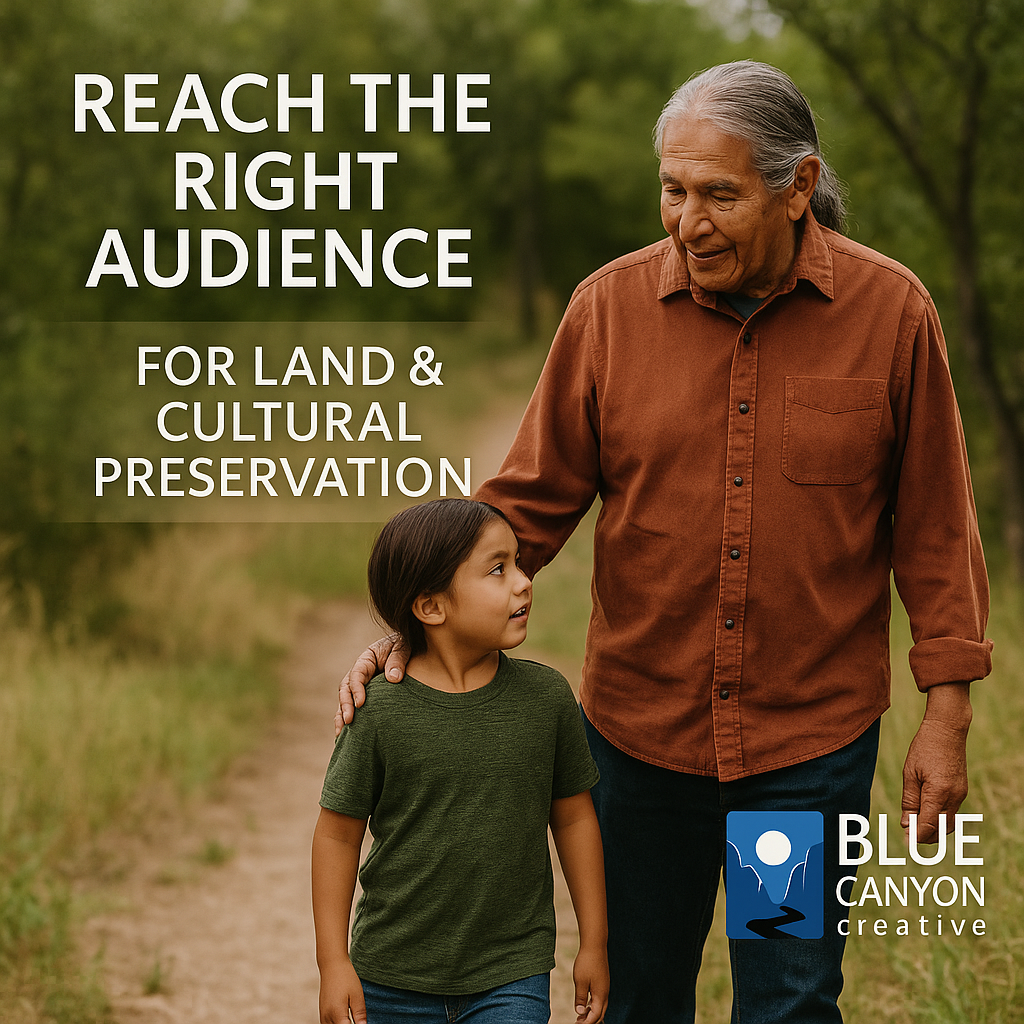How to Reach the Right Audience for Land & Cultural Preservation Work
Whether you’re preserving sacred land, protecting archives, or curating history through a museum or tribal initiative—your work matters. But if the right people don’t know about it—or don’t understand it—your mission stays quiet, underfunded, and misunderstood.
In the world of land and cultural preservation, your audience isn’t everyone. It’s the people who share your values, resonate with your story, and believe your work is essential. That’s who we’re here to help you reach.
Below are real-world, marketing-driven strategies to refine your messaging and get it in front of those who are ready to listen, support, and act.
1. Start With Shared Values, Not Just Facts
Facts tell. Values connect.
You might be tempted to lead with acreage saved, documents digitized, or events hosted—but numbers don’t inspire action unless they mean something to the audience.
Example: Instead of saying “We’ve restored 300 acres of historic farmland,” try:
“Every acre we restore helps protect a living story passed down through generations. And your support helps us preserve it for those who come next.”
Marketing tip: On your website and social media, lead with the why behind the work before diving into statistics. Shared values build emotional connection—and emotional connection leads to support.
2. Segment Your Audience—Even If You’re Small
Many land trusts and cultural organizations use one-size-fits-all messaging. But your supporters aren’t all the same.
Some care about ecology. Others are moved by heritage. Some want to volunteer. Others prefer to donate from afar.
Strategy:
Create different content “paths” for different groups:
– Local families: Emphasize education, tours, and community events
– Donors and philanthropists: Focus on legacy, impact, and preservation urgency
– Cultural advocates: Highlight identity, history, and intergenerational knowledge
Marketing tip: Use email list segmentation (even basic tags) to speak more directly to each audience type over time. Personalization builds loyalty.
3. Don’t Assume Everyone Knows Why It Matters
It’s easy to overestimate how much the public understands the importance of conservation or cultural preservation.
But just because it’s urgent to you doesn’t mean it’s clear to them.
What to do:
– Break it down: Use everyday language to explain why your work matters
– Be specific: Share examples of what would be lost without your organization
– Be visual: Photos, maps, and storytelling videos go further than long paragraphs
Marketing tip: Feature real stories—elders, youth, volunteers, or land stewards—to make your mission tangible. These stories should be repurposed across your blog, newsletter, and social channels.
4. Use Location as an Engagement Advantage
Unlike big-name global nonprofits, you have a local or regional story to tell. Use that to your advantage. People love to support causes that feel close to home.
For example:
If you manage a tribal archive in Oklahoma or a historic coastal site in Maine, local press, community partners, and hashtags can help you gain visibility fast.
Marketing tip: Create content that ties your mission to local events, anniversaries, or even seasonal traditions. It boosts relevance and search engine visibility.
5. Use “Quiet Authority” in Your Messaging
Cultural and land-based organizations don’t need loud, flashy marketing to earn attention. You need clarity, consistency, and quiet authority.
What does that look like?
– Clear headlines that reflect your mission
– Calm, confident tone in your web copy
– Photography that feels grounded, real, and respectful
– Avoid overused words like “innovative” or “cutting-edge” if they don’t apply
Marketing tip: Authority comes from coherence. Make sure your site, your socials, and your emails feel like they’re part of the same brand experience.
6. Partner With Aligned Organizations to Cross-Pollinate Audiences
One of the fastest ways to expand your reach is to work with those who already have your audience.
Consider partnerships with:
– Environmental or cultural education nonprofits
– Indigenous-led organizations with aligned missions
– Regional tourism boards
– Local media outlets or university departments
Marketing tip: Don’t just share each other’s posts—create collaborative content. That might be a co-hosted webinar, a cross-published blog, or a joint storytelling campaign.
7. Update Your Website to Reflect the Audience You Want to Attract
Your website should reflect who you’re trying to reach, not just what you’ve done.
Ask yourself:
– Is the homepage welcoming and clear within the first 5 seconds?
– Do you have a dedicated page for community members to get involved?
– Are your donation pages written like a conversation or like a transaction?
Marketing tip: Add testimonials, land acknowledgments, and behind-the-scenes videos to humanize your mission. These trust signals increase engagement across all audience types.
Final Thought
The audience for land and cultural preservation is out there. They’re looking for meaningful causes to support—but they need to see themselves in your message.
If your mission deserves attention (and it does), then your marketing should rise to meet it. You don’t need to go viral—you need to go authentic. That’s how lasting support is built.
Busy and overwhelmed and need us to help you get that audience you’ve been searching for? CONTACT US NOW and let’s talk!







